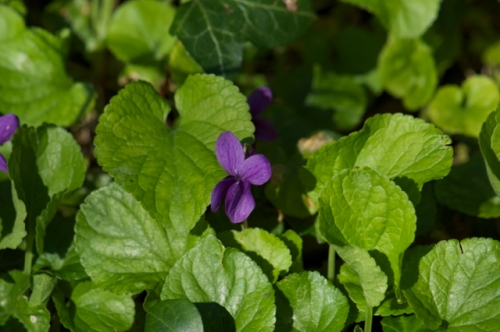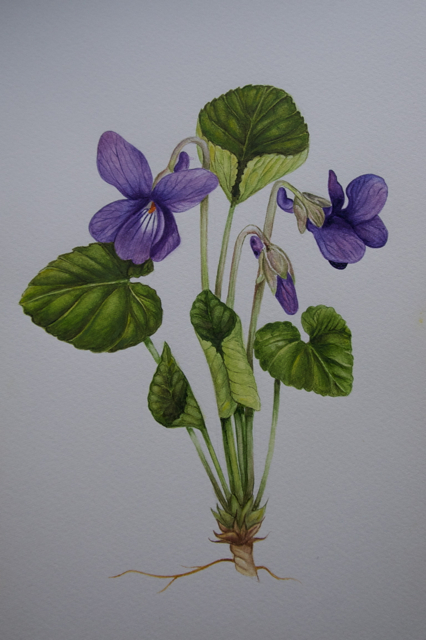Here in the UK spring is springing, new life abounds and people are visibly more relaxed and open as the sun gently warms their faces. We have been out on the Downs, sampling the spring greens and enjoying all the sights and sounds of nature.
What a lovely time of year this is, not least because of the swathes of violets that carpet areas of the woods and verges. Violet is surely one of our most treasured spring plants and is synonymous with the return of brighter days as the wheel of the year cycles round. I have written a few posts on violet before but this year I wanted to write a little more about why it is such a lovely spring tonic herb and how well its virtues are rooted in the season.
Firstly violet is a wonderful herb for awakening the lymphatic system which functions, in simplistic terms, as a kind of waste disposal and treatment facility for the body tissues. It carries the lymph fluid that originates from blood plasma through a series of ducts and nodes which are also primary sites for immune activity. Lymph nodes become swollen when overloaded which we notice as hard or raised glands. Conditions such as sinusitis, ear problems and breast tenderness are all connected to under functioning lymphatics. The lymph tends to become quite sluggish over the winter months due to the fact that we move less, eat more and the cold contracts our vessels and thickens fluids. Spring is the most wonderful time to give your lymphatic system some love by moving your body, breathing deeply and enjoying spring greens like violets and cleavers. The lymphatic system has no pump of its own so is reliant on the movement of the muscles, the blood circulation and the breath to assist it around the body. It is in this relationship of fluids and movement that I see violet’s qualities coming to the fore.
Violet is considered a cooling, moist herb. When I consume the flowers fresh or as a tea my first impression is of the demulcent quality it is famed for, but always there is a slightly astringent after effect, a subtle yet noticeable toning. The combination of soothing moisture and gentle tonification reflects the relationship between tension and relaxation that the lymphatic system needs to move freely and do its work effectively. The leaves alone are more straight forwardly demulcent, helping to keep our body’s fluids flowing.
Secondly it is rich in minerals and vitamins and helps to restore lost nutrients after the months of winter stodge (what another roast potato? I don’t mind if I do!). It has that light, fresh greenness that our bodies crave when the warmer weather arrives and it contains plentiful vitamin A and C along with other antioxidants.
Next it can be helpful for sore throats and dry coughs or those where the mucus is sticky and not easily expelled, afflictions which can often strike at the change of season as warmer temperatures encourage bugs to multiply.
Fourthly it is beautiful aromatic, a quality which uplifts and opens us physically, mentally and emotionally after we have been more closed in over winter. The fragrance on the wind helps us to breath more deeply, which in itself improves lymphatic flow and expulsion of toxins through the lungs.
Finally, and somewhat metaphorically, it is a great herb for childhood which has long been associated with the springtime of life. It has a number of useful applications; as a syrup or honey in the over ones for coughs and sore throats or to ease mild constipation and also as an infused oil made into a salve or cream for easing dry skin conditions. My little one has been sampling his first violets this spring and has been enjoying the tea diluted in his beaker for the last few days.
Violet tea made with the fresh leaf and flower turns the most beautiful colour – vivid green if you include mainly leaf and rich turquoise with the addition of more flowers.
Violet is the perfect example of medicine that is more than the sum of its constituents.
Whist it is not perhaps the strongest acting of herbs when it is tinctured and bottled, though of course it still has valuable uses, when it is admired in the wild, eaten and drunk as part of a seasonal diet and appreciated for it’s beauty, violet is perhaps one of the best spring medicines we have. We tend to think about constituents and medicinal actions as something apart from how we experience the plant in our bodies – our senses being subjective and treacherous when compared to cold, hard science – but, much like spring itself, violets help you to feel well through their simple act of being.
You can read more about violets as medicine in this post here or see here for information about using them in a breast massage oil. Also here is a recent and informative post written by American herbalist Jim McDonald.
































